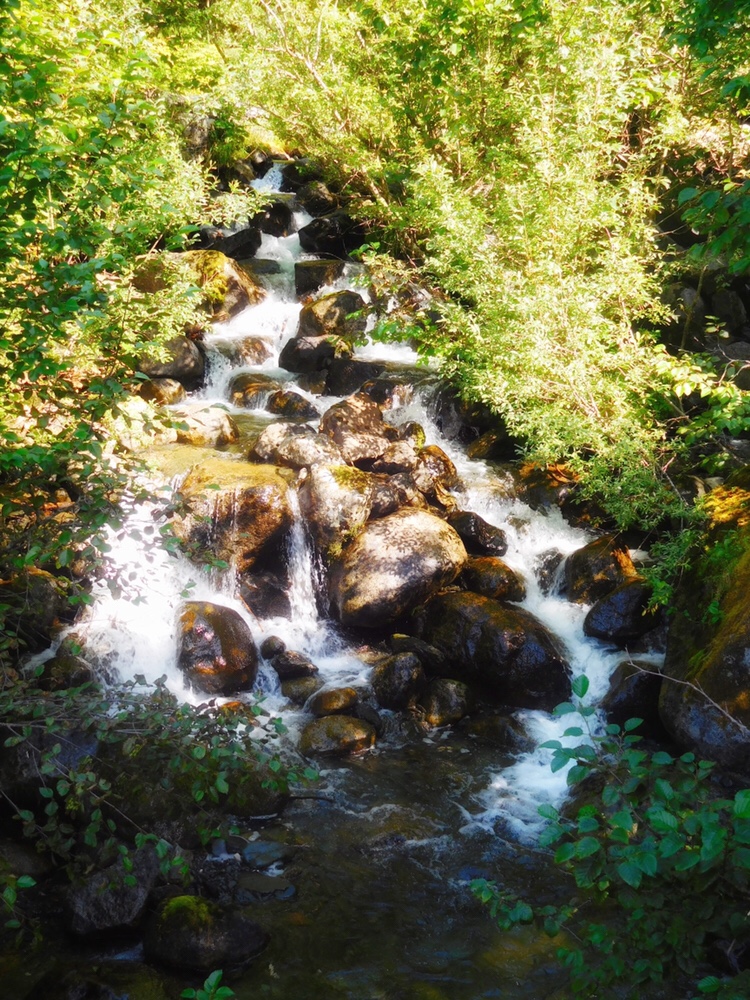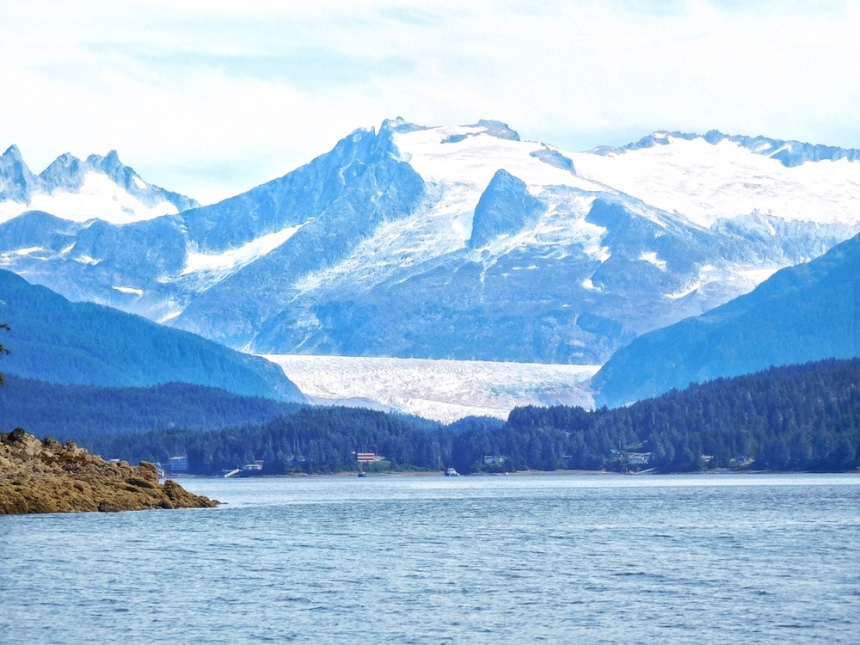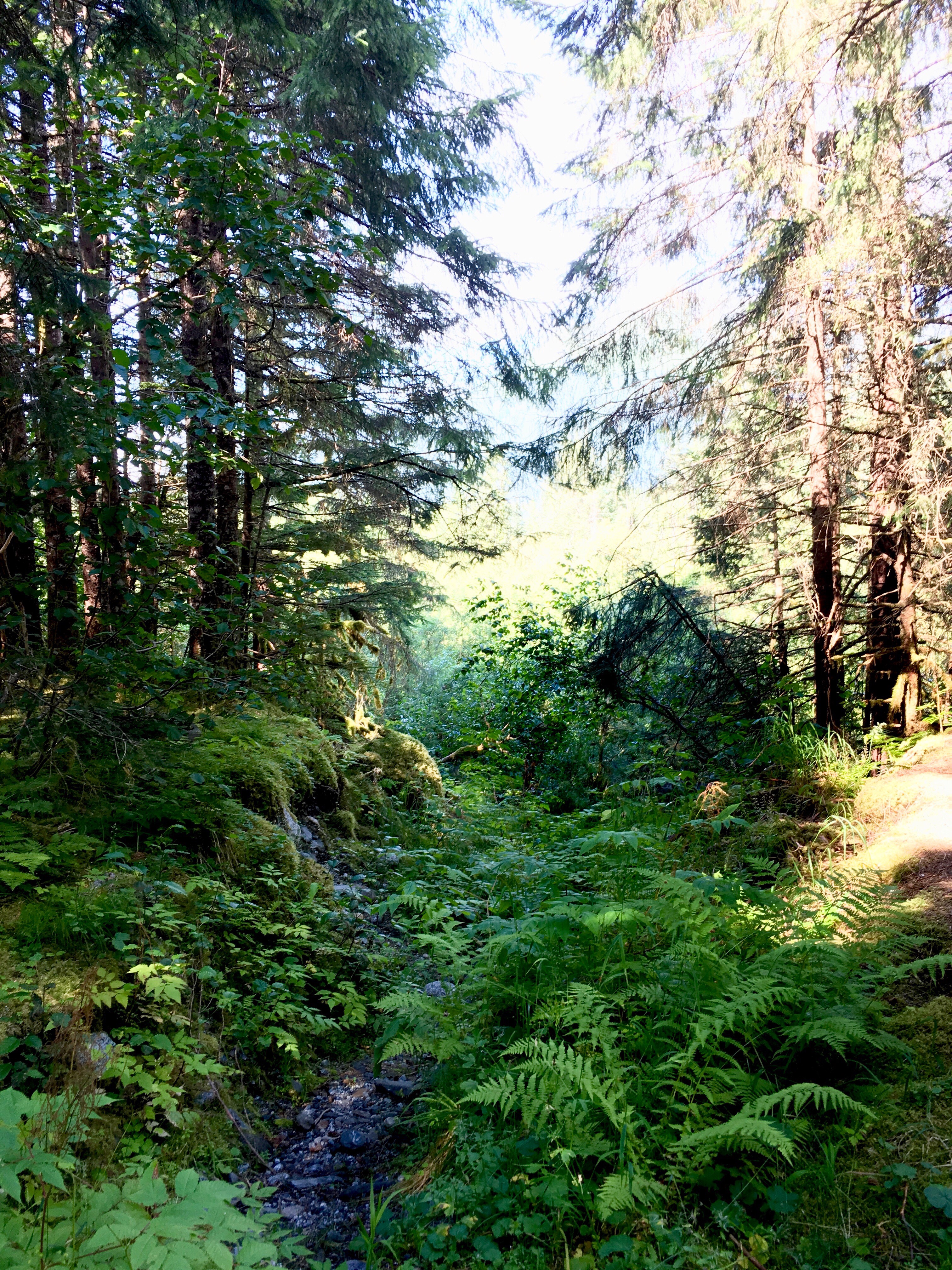From Forests to Fjords: Discovering Southeast Alaska’s Stunning Landscapes
Author’s note: This is the third installment in a series providing A Beginner’s Guide to Alaska. See the previous two posts: “Tip of the Iceberg” and “Viewing Wildlife“. Stay tuned tomorrow for the last the Juneau Ice Field.

The brief walks we took through Alaska’s temperate rain forests were among the shortest, easiest, but most beautiful trails I have experienced. I had imagined dense, dry woods in Alaska, not the lush greenery that I actually witnessed; these rain forests were overgrown, damp, and cool, unlike their warmer, tropical counterparts. They also have fewer species of vegetation, and trees that are much older as well.

Icy Strait Point

We experienced the Tongass National Forest, America’s largest national forest, first in Hoonah (Icy Strait Point), when we walked a short trail behind the fishing village just around dusk. We had completed a whale-watching tour and had about an hour and a half more to spare before getting back to the cruise shop. Since the village is small, we had already walked through the gift shop and the cannery museum, so we found a nature trail behind the building to walk.
 Even though the path looped through the forest along the coast–very close to where the ship was docked and within earshot of other tourists– the moment we entered the woods, we couldn’t hear a thing. Silence and shadows engulfed us. So dense are these forests that they shield you from the outside elements. It felt like we had entered a completely different place, and for a moment, I hesitated to walk further because it was suddenly dark and quiet. However, I remembered that the trail was very short and close to civilization so it was completely safe.
Even though the path looped through the forest along the coast–very close to where the ship was docked and within earshot of other tourists– the moment we entered the woods, we couldn’t hear a thing. Silence and shadows engulfed us. So dense are these forests that they shield you from the outside elements. It felt like we had entered a completely different place, and for a moment, I hesitated to walk further because it was suddenly dark and quiet. However, I remembered that the trail was very short and close to civilization so it was completely safe.
I’m so glad that I proceeded.
Within just a few minutes, we reached a (relative) clearing where the sun’s rays managed to slice through the trees at just the right time, gilding the tree trunks and imbuing the forest in an aurous glow.

The soil under our feet was soft, and the tree roots and logs were covered in a spongy moss. It reminded me of a scene from the Twilight movies, except we weren’t being chased by vampires or werewolves. The Tongass covers most of southeast Alaska’s Inside Passage area, according to the USDA, and that’s why we could explore it at each and every stop along the cruise’s path.
Within moments, we were back along the rocky shore in front of the cruise ship, but that brief walk through the trees left a lasting impression.

Misty Fjords
In Ketchikan, we took a smaller “cruise” to the Misty Fjords National Monument through the coastal parts of the Tongass National Forest. We kept our eyes peeled to catch whales, otters and seals in the water, and scoured the treetops for bald eagles perched in the branches.

If you’re wondering what a fjord is, imagine the Sierra Nevada range, except the escarpments drop sharply down to a narrow inlet of water. Here, carpeted cliffs thrust to the skies from the sea, and cruising through the fjords, I could see why John Muir once described these cliffs as the “Yosemite of the north.”

After all, the same forces that shaped Yosemite’s features have shaped the fjords here as well: Carved by glaciers, many of the smooth, steep rock faces near Ketchikan resembled Yosemite’s Half Dome and El Capitan. Even the approach into the fjords reminded me of Tunnel View.

Juneau
In Juneau, on the lookout for bears, we explored the forests once again by foot near the Mendenhall Glacier.

Currently, the glacier’s terminus is located 10 miles from downtown Juneau, but it wasn’t always that far away. We walked through the Tongass on the Trail of Time, so named because this roughly 1-mile loop takes you through a path that was once covered by ice, demonstrating various stages of the glacier’s retreat through the ages, and evidence of global warming’s impact.

This 13-mile long glacier has been melting into the Mendenhall Lake below, where tourists now kayak the waters. In 2016, University of Alaska, Fairbanks researchers reported that by the end of the century, people would no longer able to see the glacier’s terminus from the visitor’s centers, which is close to the view point where we viewed the glacier.
The Mendenhall is one of 38 glaciers flowing from the 1,500 square mile Juneau Ice Field, according to Alaska’s tourism website.

Walking the trail that day I saw firsthand how powerful glacial forces can be in forming surrounding ecosystems. In Alaska, ice and snow have not only shaped the landscapes, but also the way of life for the locals…
Up next, the final installment: The Juneau Ice Field
Related Posts:
-
A Beginner’s Guide to Alaska: Why Cruising is Just the Tip of the Iceberg
-
Viewing Wildlife in Alaska: A Beginner’s Guide to Cruising America’s Last Frontier
-
5 Ways to Make Fit Feel Fabulous While Cruising
-
From Teton to Tongass, A Summer Spent Searching for Bears
-
7 Essential Steps for Planning a Cruise Vacation
2 Comments
Comments are closed.













[…] See the previous posts, “Tip of the Iceberg”, “Viewing Wildlife”, and “Forests & Fjords” […]
[…] Forests to Fjords: A Beginner’s Guide to Southeast Alaska’s Landscapes […]